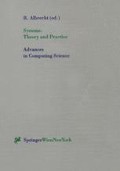Abstract
Intuitively, systems are, frequently hierarchical, aggregations of physical or mental objects, composed either by nature or composed by us for a certain purpose or for logical reasons according observable and distinguishable “properties”. Properties can be physical or logical qualities and quantities, location in physical space, behavior in physical time, physical or logical relationships between objects.
Access this chapter
Tax calculation will be finalised at checkout
Purchases are for personal use only
Preview
Unable to display preview. Download preview PDF.
References
Albrecht, R.F. (1980): Concept of a Multi-Processor Processing Unit. Computing 25, pp 1–16.
Albrecht, R.F. (1992); Design of an optional Control-and Dataflow Multiprocessor, Workshop on Parallel Processing, TU Clausthal, Informatik Report 92/1, pp 63–76.
Albrecht, R.F. (1994a) “Some Basic Concepts of Object Oriented Databases”, System Science, vol.20, No.1, Wroclaw, pp 17–30.
Albrecht, R.F. (1994b): Modelling of Computer Architectures, Proc. of the First International Conference on Massively Parallel Computing Systems (MPCS), IEEE Computer Society Press, pp 434–442.
Albrecht, R.F. (1994c): Modelling of Discrete Systems, Proc. of the 1994 Human Interaction with Complex Systems Symposium, SPIE, Greensboro, N.C., pp 204–214.
Albrecht, R.F. (1995): On the Structure of Discrete Systems, L. N. in Computer Science, Pichler, F., Diáz, R.M., Albrecht, R. (Eds.), Computer Aided Systems Theory, Springer, Heidelberg-New York, pp 3–18.
Albrecht, R.F. (1996a): The Structure of Discrete Systems, Trends in Theoretical Informatics, Albrecht, R., Herre, H. (eds.), Austrian Computer Society, Vienna, pp 127–144.
Albrecht, R.F. (1996b): Hierarchical Data Flow Concepts, Proc. 2cd Int. Conf. on Massively Parallel Computer Systems, Ischia 96, IEEE Computer Society Press, Los Alamitos, Ca., pp 8–14.
Albrecht, R.F. (1996c) Remarks on logical modelling of manufacturing systems, Proc. of the Workshop “A new mathematical approach to Manufacturing Engineering”, publ. by EICAS Automazione, Torino, pp 85–89.
Albrecht, R.F.(1997): Systems with Topological Structures. Proc. 1st Int. Conf. on “Computing Anticipatory Systems” (CASYS’97) Liège, Belgium, Aug. 11–15, ed. D. Dubois.
Albrecht, R.F., Németh G. (1997): A Generic Model for Knowledge Bases. Proc. 9th Int. Conf. on Systems Research, Informatics and Cybernetics. Baden-Baden, Germany, Aug. 18–23, ed. G.E. Lasker.
Allen, J. F. (1984): Towards a General Theory of Actions and Time. Artificial Intelligence 23, pp 123–154.
Bic, L. (1992): A Process-Oriented Model for Efficient Execution of Data Flow Programs, in Data Flow Computing, J.A. Sharp ed., Ablex Publ. Corp., Norwood, N.J., pp 332–347.
Bourbaki, N. (1951): Topologie Général, Act. Sc. In. 1142, Hermann & Cde, Paris, pp 40, 41.
Kulisch U. (1975): Formalization and Implementation of Floating Point Arithmetic, Computing 14, pp 323–348.
Kulisch U., W.L. Miranker (1981). Computer Arithmetic in Theory and Practice, Acad. Press, New York.
Kulisch U. (1996). Numerical Algorithms with Automatic Result Verification. Am. Math. Soc. Lect. in Appl. Math., 32.
Mesarovic M.D., Y. Takahara (1989): Abstract Systems Theory, L.N. in Control and Information Science, Springer, Heidelberg-New York.
Rosen R. (1985): Anticipatory Systems, Pergamon Press, New York.
Zadeh L.A. (1965): Fuzzy Sets, Information and Control 8.
Editor information
Editors and Affiliations
Rights and permissions
Copyright information
© 1998 Springer-Verlag Wien
About this chapter
Cite this chapter
Albrecht, R.F. (1998). On mathematical systems theory. In: Albrecht, R. (eds) Systems: Theory and Practice. Advances in Computing Science. Springer, Vienna. https://doi.org/10.1007/978-3-7091-6451-8_3
Download citation
DOI: https://doi.org/10.1007/978-3-7091-6451-8_3
Publisher Name: Springer, Vienna
Print ISBN: 978-3-211-83206-6
Online ISBN: 978-3-7091-6451-8
eBook Packages: Springer Book Archive

